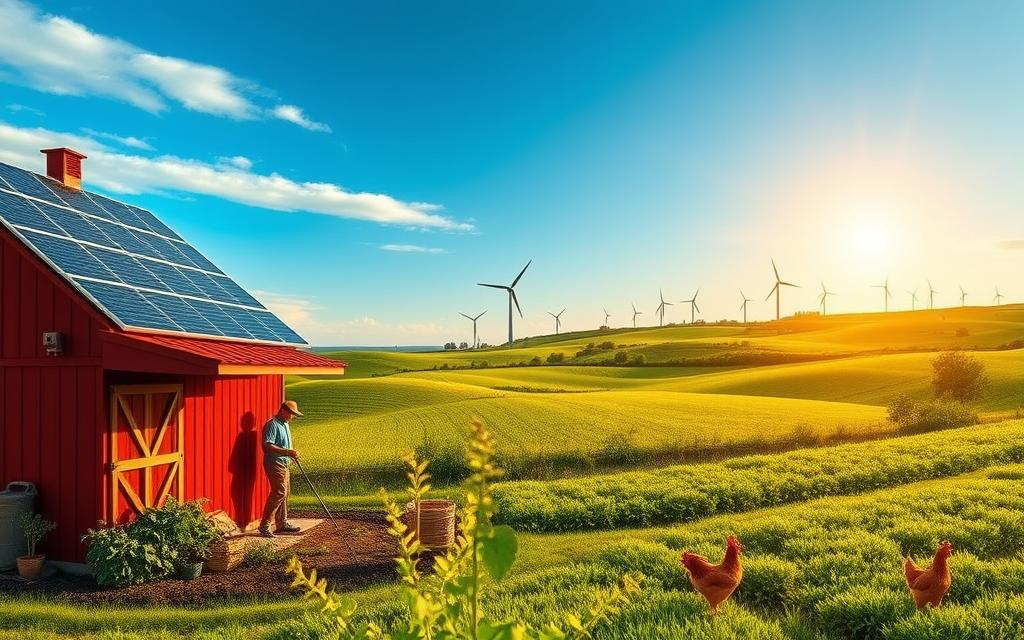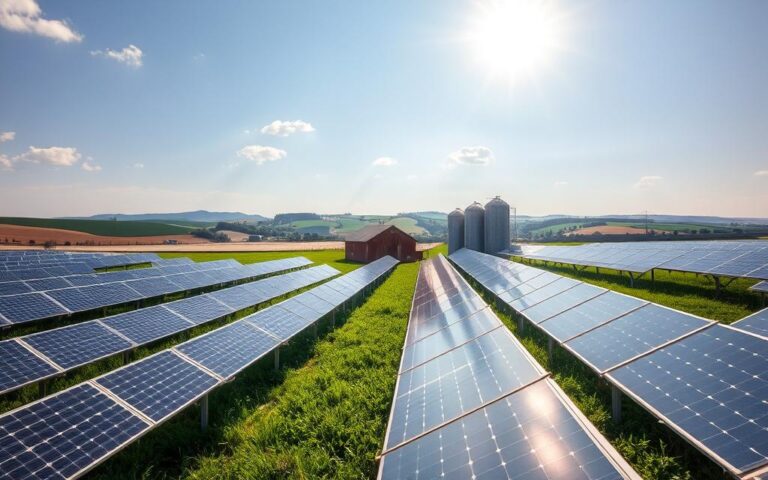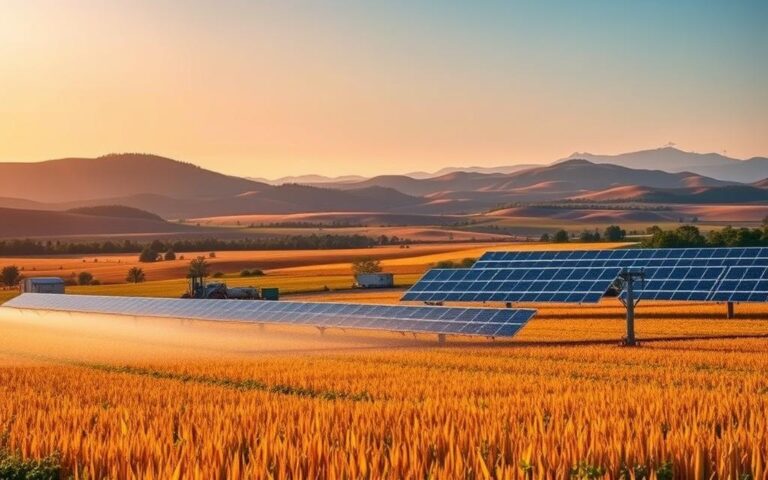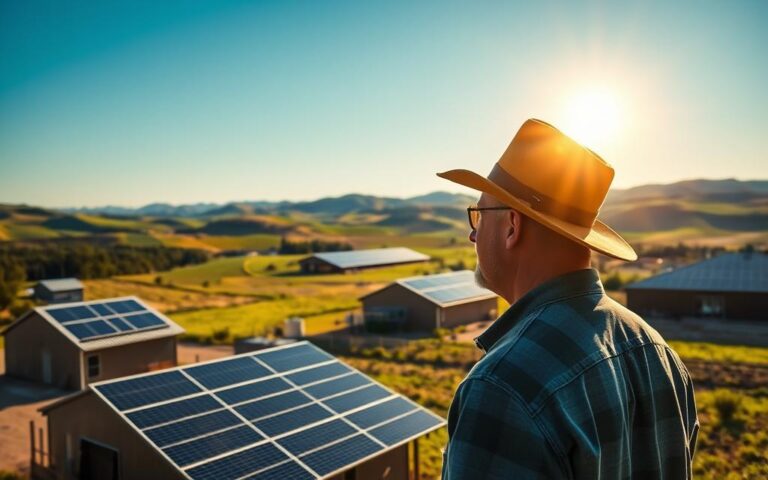Did you know U.S. farmers can cut their energy costs by up to 75% with solar power? This big change is making farming better for the planet and more affordable. As farming costs go up, solar power is a big help. It saves money and helps the environment, making farms more productive.
This article will look at how solar power is changing farming. It’s a big win for farmers and the planet.
Introduction to Solar Power in Agriculture
Solar energy is becoming key in modern farming. It’s a big step towards sustainable farming. Farmers are looking for ways to save money and protect the environment.
Solar energy helps farmers use sunlight for their needs. It makes them less dependent on expensive electricity. This change also helps them save money and protect the planet.
Studies show solar energy is good for farms. It can power things like electric fences and irrigation systems. As solar tech gets better, it will play a big role in making farming more sustainable.
Using solar energy helps farmers work better and greener. It encourages them to use clean energy for their farms and the planet.
Cost Reduction for Farmers
Switching to solar power for farming brings big financial wins. Farmers see a huge drop in energy costs. This change turns a usual expense into a chance to make money.
It helps manage costs and boosts financial health over time.
Lower Energy Bills
Using solar energy systems means lower energy costs for farmers. Unlike traditional energy, solar power is steady and green. This leads to big savings on utility bills.
These savings can be used for other important farm needs.
Reinvestment Opportunities
Money saved from lower bills can be put back into the farm. Farmers can buy new, efficient equipment or try new farming methods. These investments help the farm grow and improve over time.
| Expense Type | Before Solar Implementation | After Solar Implementation |
|---|---|---|
| Monthly Energy Bill | $1,500 | $600 |
| Annual Energy Cost | $18,000 | $7,200 |
| Reinvestment Potential (Annual Savings) | N/A | $10,800 |
Sustainability and Environmental Impact
Solar power is changing farming in big ways, beyond just saving money. It’s great for the planet too. By using solar energy, farmers cut down on harmful emissions and choose cleaner power.
Reduction of Carbon Footprint
Switching to solar energy cuts down on carbon emissions a lot. Old energy sources like coal and gas release a lot of bad stuff into the air. Solar power, on the other hand, uses the sun’s energy, making farming kinder to the earth.
Eco-Friendly Practices
Solar tech brings many green farming methods. For example, solar-powered irrigation saves water and energy. This helps farmers use water wisely and grow food in a greener way. Solar power helps farms be better for the planet, leading the way for others.
Improved Energy Independence
Farmers are seeing the benefits of solar energy for their energy needs. They can make their own electricity, which is great for places far from power plants. This way, they save money and feel in charge of their energy.
Reliability in Remote Locations
In rural areas, getting steady power is hard. Solar systems solve this problem by making clean energy. They keep things like irrigation and animal care going, even when the power goes out.
Decreased Dependency on Fossil Fuels
Switching to solar energy helps farmers use less fossil fuels. This move supports green farming and boosts energy freedom. It also helps the planet and shows the value of solar power in farming.
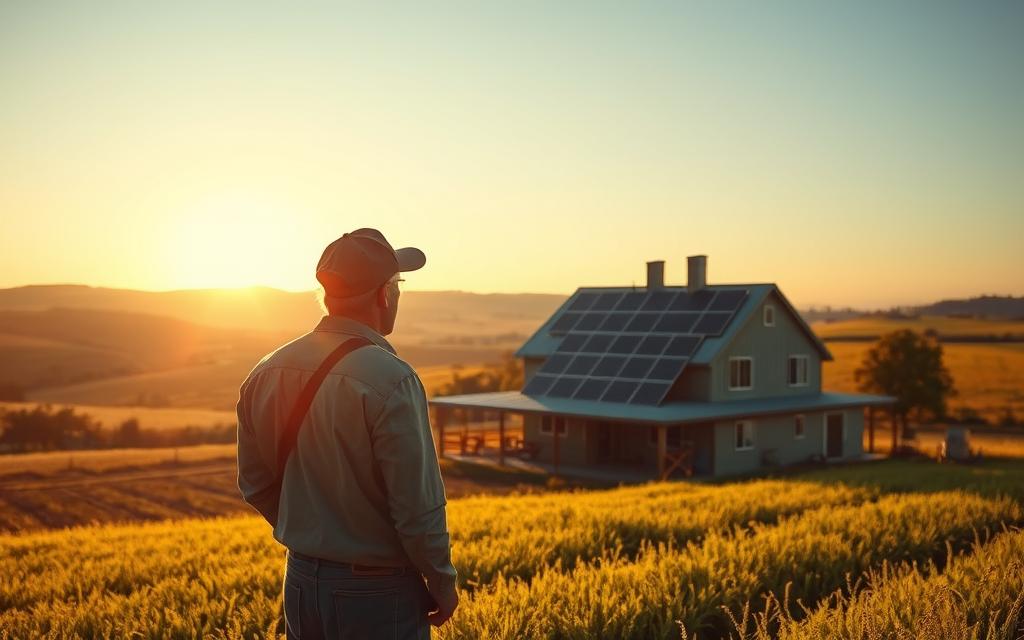
Enhanced Agricultural Efficiency
Using solar energy in farming makes farming more efficient. It brings in renewable energy to power farm tools and automate tasks. This leads to better farm output, letting farmers do more with less effort and resources.
Automated Irrigation Systems
Solar-powered irrigation systems help farmers use water wisely. They water crops just right, keeping them healthy and saving water. This smart watering cuts down on waste and boosts crop yields.
Powering Farm Equipment
Solar panels power farm tools like machinery and coolers for fresh produce. This cuts down on costs and keeps work going without breaks. It’s a big step towards making farming more automated and productive.
Water Conservation through Solar Solutions
Solar-powered solutions are key for saving water in farming. They offer farmers a green and affordable way to water their crops. This method cuts down on fossil fuel use and helps manage water better.
It’s especially important in areas where water is scarce. Sustainable farming is crucial here.
Solar-Powered Water Pumps
Solar-powered water pumps are a big step forward in efficient irrigation solutions. They work without the need for old energy sources. This lets farmers use clean energy for their water needs.
The benefits are clear:
- They save money because they use little electricity.
- They bring water to places that are hard to reach.
- They’re better for the environment, helping with water conservation.
Efficient Irrigation Management
Using solar-powered irrigation systems improves how farmers manage water. They can track and control their water use better. This leads to less waste and better use of water.
The main benefits are:
- They get real-time data for better decisions.
- They automate watering to match what crops need.
- They help crops grow better by using water just right.
Renewable Energy for Farmers
Farmers who use solar energy can save a lot of money over time. As energy prices go up, solar power helps farmers cut costs. This means they can make more money and focus on other important parts of their farm.
Long-Term Financial Benefits
Switching to solar energy lowers energy bills, saving farmers a lot of money. By using their own solar power, farmers don’t have to rely as much on expensive utility services. This makes it easier to plan their budgets and finances.
Access to Government Incentives
Government programs like the Rural Energy for America Program (REAP) help farmers go solar. These programs offer grants and loans, making it easier for farmers to start using solar energy. This support helps many farmers make the switch to renewable energy.
| Benefit | Description | Impact on Farmers |
|---|---|---|
| Reduced Energy Bills | Lowering utility costs through solar energy production. | Increased cash flow for reinvestment. |
| Government Grants | Financial aid available through various programs. | Lower initial investment barriers. |
| Tax Credits | Incentives that reduce federal tax liabilities for solar investments. | Enhanced return on investment. |
| Energy Independence | Reliance on self-generated electricity rather than the grid. | Stability against price hikes and outages. |
Job Creation and Economic Growth in Rural Areas
Solar energy in agriculture brings big changes to rural areas. It creates jobs and helps the local economy grow. Farmers who use solar energy help meet global goals for a sustainable future.
Local Job Opportunities
Setting up and keeping solar systems running creates jobs. People with technical skills are needed for installation. Maintenance jobs also require workers to keep systems working well.
This need for skilled workers helps rural areas with high joblessness. Training programs can improve skills, matching local education with solar industry needs.
Boosting Community Economies
Solar energy does more than just create jobs. It helps farmers save money, which they can then use to grow their businesses. This boosts the local economy by increasing spending and supporting small businesses.
Also, solar projects can make properties more valuable. This makes the area more attractive to new residents and businesses. It helps the community grow and thrive.
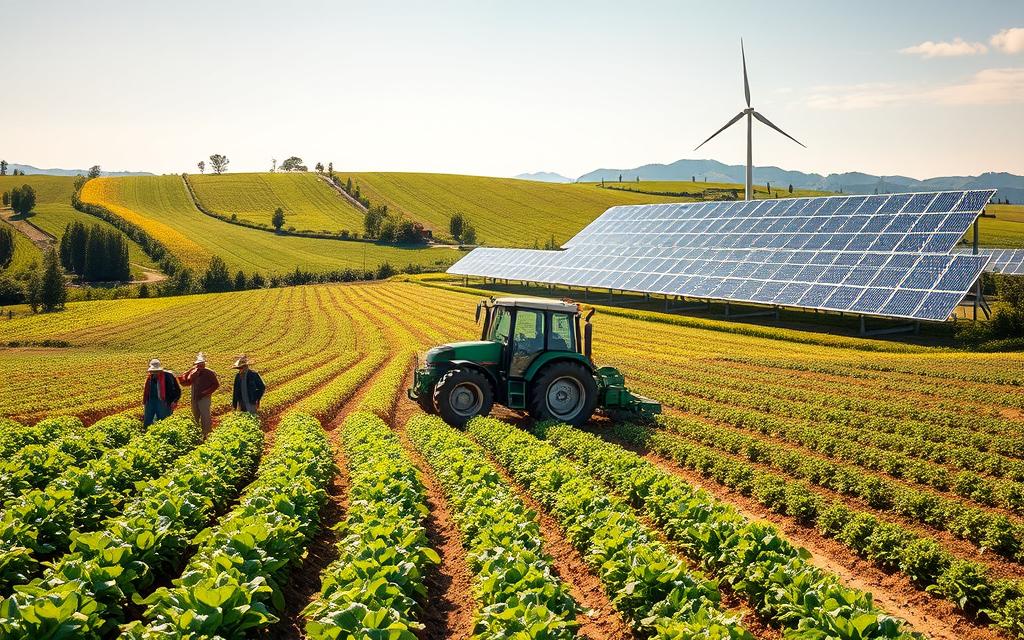
The Role of Agrivoltaics in Sustainable Farming
Agrivoltaics is a new way to farm that uses solar energy and grows crops together. It makes better use of land, which is key for sustainable farming. Farmers can grow food and make clean energy at the same time, meeting two big needs.
Simultaneous Land Use
Putting solar panels in farms lets farmers grow crops and make energy on the same land. This way, farmers don’t have to pick between farming and making energy. Agrivoltaics helps farmers keep growing crops and also makes electricity for themselves or to sell.
Increasing Crop Yields
Solar panels can help crops grow better. They keep water in the soil and reduce water loss, making plants healthier. This can lead to better quality crops. Using agrivoltaics, farmers can grow more food and help the environment at the same time.
Challenges and Considerations in Solar Energy Adoption
Farmers looking into solar energy face big hurdles. It’s key to know these challenges to make smart choices. High costs and limited space are major obstacles. Finding ways to overcome these can help farmers use solar energy effectively.
High Initial Costs
Setting up solar systems costs a lot at first. This is a big problem for many farmers. They might look into loans or government help to cover these costs. Without support, starting a solar project seems too hard for many.
Land and Space Requirements
Enough space for solar panels is another big issue. Small farms often struggle to find room. Farmers need to plan carefully to fit panels without hurting their farming work. This planning is crucial for success.
Conclusion
Solar power brings many benefits to U.S. farmers, leading to a greener future in agriculture. It helps farmers cut down on costs and work more efficiently. Plus, it’s good for the planet.
Solar power does more than save money. It makes farmers less dependent on fossil fuels and promotes green farming. As more farmers use solar, they help the environment and support renewable energy.
By looking into solar options, farmers can do well in a changing world. Solar energy systems make farming sustainable and help farmers save money and protect the environment. It’s a smart move towards a better, eco-friendly future.

